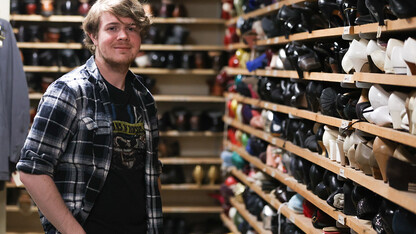· 14 min read
Nebraska in the national news: October 2020

A University of Nebraska–Lincoln professor’s 20-year quest to understand the odd behavior of football passes was featured in two prominent national media outlets in October. The stories were among 50-plus featuring Husker faculty, staff, students, centers and programs during the month.
Tim Gay, Cather Professor of physics and astronomy, and colleagues recently solved a football physics conundrum: On a deep, well-thrown pass, why does the front tip of a football follow the ball’s trajectory, so that it points upward when launched but downward by the time it reaches a receiver? The answer lies in the combination of air resistance and the gyroscope effect.
Gay, author of “The Physics of Football” and a former Caltech player, enlisted the help of two theoretical physicists — his former teammate, Willie Moss of the Lawrence Livermore National Laboratory, and Richard Price of MIT — to answer the question. Their paper, “The Paradox of the Tight Spiral Pass in American Football: A Simple Resolution,” was recently published in the American Journal of Physics. The New York Times and Wall Street Journal highlighted the research.
Asked by the Journal if the findings could be used to make a quarterback a better passer, Gay said “potentially, yes.” Still, he cautioned: “It would not be a big effect. I don’t think this is going to in any way revolutionize the game of football. It might help a little bit.”
Gay also discussed football physics for an Oct. 22 KLKN story.
More coverage:
John Hibbing’s new book, “The Securitarian Personality,” was featured in an Oct. 1 column by The New York Times’ David Brooks. In the book, Hibbing, political science, argues that people on the right of the political spectrum tend to react to threats coming from outside America, while people on the left see threats coming from the powerful financial and political spheres inside America. “The Securitarian Personality,” based on reporting, focus groups and surveys, is an attempt to understand what motivates the most enthusiastic Trump supporters.
Hibbing was also interviewed for an Oct. 20 Bloomberg Government article on the increased attention being paid to state legislative races in the Midwest for the purposes of Congressional redistricting. With tighter legislative control in Nebraska, the Republican Party could redraw the state’s 2nd Congressional District to lock in an electoral vote for a Republican president, Hibbing said.
The 2013 book “Predisposed” by Hibbing and Kevin Smith, political science, and Rice University’s John Alford and a 2017 study by Ingrid Haas, also political science, were featured in an Oct. 26 Scientific American article on political neuroscience. In “Predisposed,” the authors argue that political differences are rooted in personality characteristics and biological predispositions. Haas put 58 people with diverse political views in a brain scanner and asked them questions about hypothetical candidates from both major parties. She found that liberals were more attentive to incongruent information, especially for Democratic candidates.
NMotion recently launched a monthlong virtual Venture Residency program to help 10 recent college graduates push themselves to develop entrepreneurial skills and an innovation mindset. Participants had a shot at going on to the NMotion Accelerator Studio, where they would receive $100,000 of investment capital and 16 weeks of intensive mentorship and assistance to transform their ideas into real-life startups. Silicon Prairie News published an Oct. 1 article on the program.
Paul Kononoff, Nebraska Extension dairy specialist, was quoted in an Oct. 1 Progressive Dairy article on keeping water flowing to dairy cattle during the winter. “Even a small limitation in water intake will decrease dry matter intake by one to two pounds daily, which could limit peak milk production by two to five pounds,” he said.
Max Perry Mueller, classics and religious studies, was interviewed for an Oct. 2 Politico article on President Donald Trump alienating many of his former supporters in the heartland. “These folks are not political ideologues,” he said. “They march in the March for Life, they vote Republican, but they are not enamored by the kind of identity politics that Trump brings.” However, he said the issue of abortion may prevent many Trump defectors from voting for Joe Biden.
John Fech, Nebraska Extension educator, wrote a recent article for GCM on tee box maintenance tips. “Creating and maintaining an attractive and well-functioning space is a critical consideration in these locations,” he wrote. “Shade, wear, moss, surface roots, debris, non-plant elements and airflow challenge the success of a tee box, while well-placed perennials and woody plants can enhance it.”
Chigozie Obioma, English, was interviewed for an Oct. 3 segment on Blog Talk Radio. He discussed his second novel, “An Orchestra of Minorities.”
Dawn O. Braithwaite, communication studies, was interviewed for an Oct. 4 Deseret News article on government policies that could benefit American families. Congress could provide “child care which protects children and facilitates the workforce in dual-career and single-parent families,” she said. But Braithwaite’s top priority is health care. “Preserving and expanding health care could not be more important for families,” she said.
The Omaha World-Herald published an Oct. 5 article on Don Puckett, a custodian at the forefront of the COVID-19 fight at the University of Nebraska–Lincoln. He has worked at the university for 45½ years. CleanLink published an Oct. 14 story on Puckett based on the World-Herald article.
Tiffany Heng-Moss, dean of agricultural sciences and natural resources, discussed the new LPS-UNL Early College and Career STEM Program at Lincoln Northeast High School during an Oct. 6 segment on RFD-TV. Through hands-on, immersive experiences and early college pathways, the program will prepare Northeast students in the areas of food, energy, water and societal systems.
Eric Thompson, economics, director of the Bureau of Business Research, was interviewed for an Oct. 6 WKRN story on Nashville, Tennessee’s top ranking in the 2020 Barometer Report, which compares 10 high-performing metro areas. Thompson was part of the team that compiled data for the report.
Thompson was also cited in an Oct. 28 Thomson Reuters article on a drop in leisure travel stalling the global recovery in fuel demand. According to Thompson, more than two-thirds of fans who attend Husker football games come from outside the Lincoln metro area, with many driving at least 60 miles.
Cara Burberry, Earth and atmospheric sciences, was quoted in an Oct. 7 National Geographic article on a new study of an ancient rockfall in Scotland. “It does show you how much amazing detail you can pull out of one block of rock if you approach it really carefully,” she said. “They’ve documented it really beautifully.”
An article by Aaron Berger, Nebraska Extension beef educator, was highlighted in an Oct. 7 BEEF Magazine blog entry on cattle grazing corn stalks and other crop residue this fall. “Stocking rate should be determined based on corn bushel yield per acre and the average weight of cattle that will be grazing,” he wrote. “A quick way to estimate grazing days per acre available for a 1,200-pound non-lactating cow is to take corn bushel yield and divide by 3.5.”
Brad Schick and Ben Beckman, assistant extension educators with the West Central Research and Extension Center in North Platte, wrote a recent article on cattle grazing alfalfa in the fall and winter. “There is often fear associated with grazing alfalfa due to bloat potential or hurting the alfalfa stand,” they wrote. “These are very valid concerns, but with additional management and timing, alfalfa stands can provide supplemental forage.” High Plains Journal and Western Livestock Journal ran the article.
Schick also wrote a recent article on cattle grazing corn residue. “When thinking about how long to graze corn residue, the calculation to follow is that for every bushel of corn produced, there is 16 pounds of dry leaf and husk,” he wrote. “The recommended grazing plan should be to remove 50% of the leaf and husk.” Western Livestock Journal ran the article Oct. 9.
Troy Walz, extension educator at the West Central Research and Extension Center, wrote a recent article on the dangers of cattle grazing frost-covered forages. “When some forages are frosted, the potential for bloat, toxicity and nitrates may increase for grazing cattle,” he wrote. Western Livestock Journal ran the article Oct. 9.
Kevin Smith, political science, was interviewed for an Oct. 10 article in The Hill on Nebraska’s 2nd Congressional District possibly playing a pivotal role in the 2020 presidential election. Asked whether the single electoral vote might prove the difference, he said: “In previous presidential elections, my response has been ‘yeah, right.’ In 2020, who knows, it’s kind of a crazy year.”
Jonathan Larson, a Nebraska Extension entomologist for Douglas and Sarpy counties, was featured in an Oct. 10 KCRR story on the minute pirate bug. He said the insects don’t inject anything when they bite or take a sip of blood; they’re just trying to figure out if people are edible.
Bedross Der Matossian, history, is among 100 scholars of Armenian descent who have petitioned to stop Azerbaijan’s military aggression toward Armenians. The scholars were listed in an Oct. 12 Armenian Mirror-Spectator article.
Der Matossian was also interviewed for an Oct. 23 Le Monde Diplomatique article on the conflict. “The anti-Armenian discourse fueled by both governments in Turkey and Azerbaijan and their military actions against the vulnerable Republic of Armenia are manifestations of genocidal tendencies of both authoritarian regimes,” he said.
Marc A. Garcia, sociology and ethnic studies, and colleagues have found that higher educational attainment among adults is associated with better cognitive function regardless of race and ethnicity, however whites are still living a greater percentage of their lives in good cognitive health compared to their Black and Hispanic counterparts. This suggests structural racism is playing a role, Garcia said. Home Health Choices, Medical Xpress and Technology.org ran articles on the research.
Randy Saner, Nebraska Extension educator, and J. David Aiken, Nebraska Extension water and agricultural law specialist, wrote a recent BeefWatch article on things to consider when adding hunting leases to an agricultural enterprise. The article was featured in an Oct. 14 BEEF Magazine blog entry on the topic.
Martha Shulski, Nebraska state climatologist and associate professor in the School of Natural Resources, was interviewed for an Oct. 16 article in Farm Journal’s Ag Pro on the National Oceanic and Atmospheric Administration’s winter forecast. She said Nebraska needs a wetter-than-normal winter to help make up for significant moisture deficits. However, she thinks it’s unlikely La Nina’s wetter-than-normal pattern will hit states such as Nebraska.
New research from Mark Pegg, School of Natural Resources, and colleagues, has found that pallid sturgeon stocked in a northerly segment of the Missouri River can live nearly three times longer, produce roughly 10 times as many eggs and weigh up to seven times more than specimens stocked on the Nebraska-Iowa border. Because the sturgeon at both locations came from the same genetic lineage, their disparities were likely driven almost entirely by differing characteristics of the river at the respective locations. Stories on the research appeared in the Omaha World-Herald, Science Codex and a few other outlets.
The U.S. Farm Report brought its “College Roadshow” to the university in mid-October. Faculty members Helen Fagan, Brad Lubben and Cory Walters, staff member Taylor Hart and students Caleb Durheim, Elizabeth Karnopp and Amanda Most were featured in the program.
Justin “Gus” Hurwitz, law, director of the Nebraska Governance and Technology Center, was interviewed for an Oct. 20 Salon article on politicians wanting to strengthen antitrust laws against Big Tech companies. He said the narrative of “little guy” companies growing dangerously big is consistent with perceptions of technology corporations since the late 20th century. Companies that were once heralded for their innovation are now perceived with suspicion over concerns such as the belief that they violate users’ privacy and discriminate against conservative voices.
Mike Boehm, Harlan Vice Chancellor for the Institute of Agriculture and Natural Resources and vice president for agriculture and natural resources at the University of Nebraska system, discussed the university’s new Water, Climate and Health program during an Oct. 20 segment on RFD-TV.
Carrick Detweiler, computer science and engineering, CEO and co-founder of Drone Amplified, wrote an Oct. 21 guest column for Fire Aviation on Congress considering banning all drone parts made outside of the United States. “Instead, policymakers in Washington should set national standards that would apply to everybody, whether the technology is made in China, France or the United States,” he wrote.
Silicon Prairie News published an Oct. 21 article on the Combine Incubator at Nebraska Innovation Campus. Six startups are currently participating in the year-old program.
A performance of the off-Broadway hit “NEWSical the Musical,” filmed at the Lied Center for Performing Arts on Sept. 26, was streamed live Oct. 26 and available on demand through Nov. 2 at StellarTickets.com, Broadway World reported Oct. 22. Proceeds benefited the Actors Fund and the Lied Center.
Megan Elliott, founding director of the Johnny Carson Center for Emerging Media Arts, was the featured guest on “The Virtual Excellence Show” on Oct. 22. She discussed how the Carson Center has adjusted to the COVID-19 pandemic and the work students and faculty are doing in virtual and augmented reality.
Brad Lubben, agricultural economics, was interviewed for an Oct. 23 High Plains Journal article on the farm economy. Federal assistance has pushed farm income higher the past three years, he said. “That also means it has pushed off some of the difficult economic decisions that would need to be made in response to lower prices, including production decisions, equipment investment and land values,” he said. “Barring further assistance next year, the real cash flow crunch could come in 2021, even if market prices are modestly higher.”
Eric Berger, law, was a guest on the Oct. 24 episode of the Faithful Politics podcast. He discussed clerking for Judge Merrick Garland, the U.S. Supreme Court confirmation hearings, the role of the high court and other constitutional law topics.
New research from Matthew Van Den Broeke, Earth and atmospheric sciences, has found that the density of migrating birds is generally lower in the wake of isolated thunderstorms. The effect was more pronounced in the fall than the spring, suggesting that birds migrating north to their breeding grounds may be more likely to fly through storms for the sake of arriving on time. Technology.org ran an Oct. 27 article on the research.
Stephen Baenziger, agronomy and horticulture, has spent the past seven years studying the hybridization of wheat with Texas A&M’s Amir Ibrahim. The team’s newest project is supported by a $650,000 U.S. Department of Agriculture National Institute of Food and Agriculture grant. AgFax and Seed Today ran articles on the collaboration.
The U.S. Department of Energy has committed $18 million to continue LaserNetUS, a high-power laser consortium that includes the Extreme Light Laboratory at Nebraska. Stories on the new grant funding appeared in KNEB, Photonics.com, Scienmag, Technology Today and several other media outlets.
Aila Ganic, a junior political science major involved with the College of Journalism and Mass Communications’ Climate Change Nebraska project, wrote an Oct. 28 article about being a young activist for Katie Couric’s Wake-Up Call newsletter. “I scroll through Twitter and constantly see headlines about habitats we’ve ruined, animals that have gone extinct and humans whose lives have been destroyed by natural disasters,” she wrote. “This isn’t just an environmental problem, it’s a people problem.”
Today’s Producer ran an Oct. 28 article on Mary Jane Frogge, horticulture extension associate with Nebraska Extension, who recently celebrated 30 years with the university. Her responsibilities include supervising the Master Gardener program in five counties and educating youth on horticulture, wildlife, forestry and the like.
Jay Stafstrom, a postdoctoral researcher at Cornell University and Husker alumnus; Eileen Hebets, biological sciences; and Ronald Hoy, professor of neurobiology and behavior at Cornell, have co-authored a study showing that the ogre-faced spider relies on hearing, rather than its massive eyes, to catch airborne prey. CNN.com published an Oct. 29 article on the research. The story was picked up by more than 50 media outlets.
Aaron Duncan, communication studies, wrote an Oct. 29 piece for The Conversation on how Twitter’s structure allows “logical fallacies” to thrive. The article was picked up Fast Company, the Houston Chronicle, Snopes.com, Yahoo News and several other media outlets.
Dirac Twidwell, agronomy and horticulture, was interviewed for an Oct. 29 National Audubon Society article on woody vegetation invading grasslands. Twidwell is using the Rangeland Analysis Platform to help partners prioritize where to invest federal conservation funds on practices such as prescribed burns or cutting redcedar. More than 90% of the Great Plains is privately owned, he said, so these conservation efforts are essential for the prairie’s future.
Yi Xuen Tay, a graduate student in educational administration, was featured in an Oct. 29 Chronicle of Higher Education article on the presidential election having personal stakes for international students. While she can’t vote, she encourages her American friends and classmates to get to the polls. “Even if I don’t have the power to vote,” she said, “I still have a voice.”
The Food Allergy Research and Resource Program was cited in an Oct. 31 Mashed article on the ingredients in Costco’s rotisserie chicken. According to the program, trace amounts of soy protein lecithin will probably not pose a problem to the soy-allergic.
Faculty, administration, student and staff appearances in the national media are logged at http://newsroom.unl.edu/inthenews. If you have additions to this list, contact Sean Hagewood at shagewood2@unl.edu or 402-472-8514. If you have suggestions for national news stories, contact Leslie Reed at lreed5@unl.edu or 402-472-2059.







